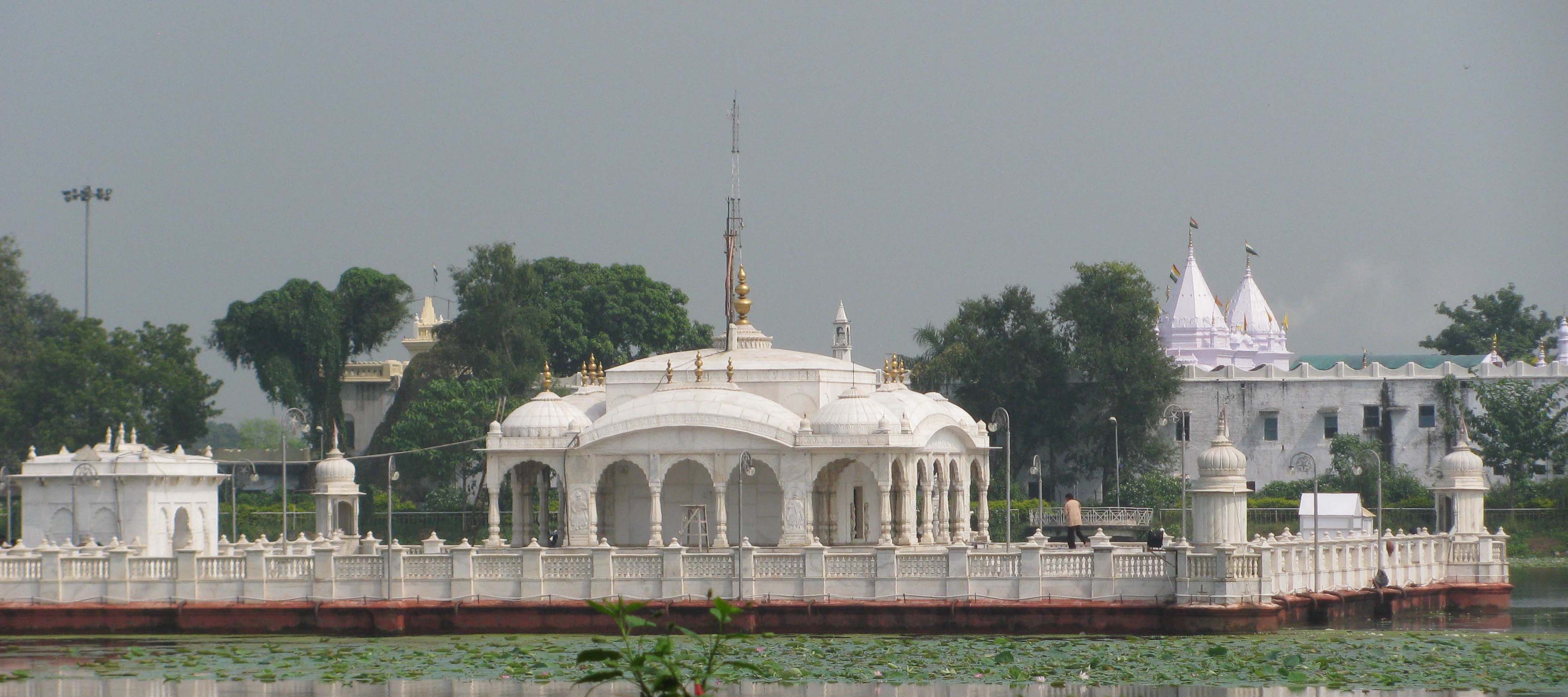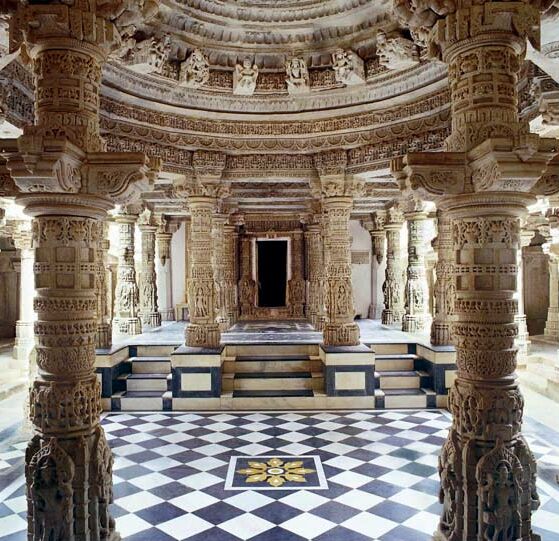|
Shree Pavapuri Tirth Dham
Shree Pavapuri Tirth Dham is situated at Sirohi district of Rajasthan. This temple was built by K. P. Sanghvi Group and it comprises a Jain Tirth (Temple complex) and Jeev Raksha Kendra (Animal Welfare Center). Campus The Tirth derived its name after the Pavada Agriculture well that exists there. Shri Kumarpalbhai V. Shah inspired Late Shri Hajarimalji Poonamchandji Sanghvi (Bafna) and Shri Babulalji Poonamchandji Sanghvi (Bafna), the founders of K. P. Sanghvi Group, to construct a Tirth Dham. They started construction and development of the campus on 30 May 1998, Saturday (Jeth Shukla 15, 2054 V. S.). The initial thought was to construct a small temple and a shelter for 100 cows only but the campus is now spread over more than of land. The temple complex occupies area and the Jeev Raksha Kendra (Animal Welfare Center) occupies . It took two and a half years to construct the temple with an average of 400 artisans working daily. The construction was completed on 7 February ... [...More Info...] [...Related Items...] OR: [Wikipedia] [Google] [Baidu] |
Mahavira
Mahavira (Sanskrit: महावीर) also known as Vardhaman, was the 24th ''tirthankara'' (supreme preacher) of Jainism. He was the spiritual successor of the 23rd ''tirthankara'' Parshvanatha. Mahavira was born in the early part of the 6th century BCE into a royal Kshatriya Jain family in ancient India. His mother's name was Trishala and his father's name was Siddhartha. They were lay devotees of Parshvanatha. Mahavira abandoned all worldly possessions at the age of about 30 and left home in pursuit of spiritual awakening, becoming an ascetic. Mahavira practiced intense meditation and severe austerities for twelve and a half years, after which he attained '' Kevala Jnana'' (omniscience). He preached for 30 years and attained Moksha (liberation) in the 6th century BCE, although the year varies by sect. Historically, Mahavira, who revived and preached Jainism in ancient India, was an older contemporary of Gautama Buddha. Jains celebrate ''Mahavir Janma Kalyanak'' every yea ... [...More Info...] [...Related Items...] OR: [Wikipedia] [Google] [Baidu] |
Goshala
Gaushalas or Goshalas ( hi, गौशाला, gauśālā) are protective shelters for stray cow in India. Stray cows are unproductive. Government grants and donations are the primary source of income of the cow shelters in India. Since 2014, when BJP government came into power in India, India has spent on cow shelters in two years between 2014 and 2016. Description Goshala, a Sanskrit word ("Go" means cow and "Shala" means a shelter place: Go + Shala = shelter for cows), means the abode or sanctuary for cows, calves and oxen. History India's first goshala is thought to have been established in Rewari by Raja Rao Yudhishter Singh Yadav. There are now goshalas all over India. The first ''Gaurakshini sabha'' ( cow protection society) was established in Punjab in 1882. The movement spread rapidly all over North India and to Bengal, Bombay, Madras presidencies and other central provinces. The organization rescued wandering cows and reclaimed them to groom them in places ... [...More Info...] [...Related Items...] OR: [Wikipedia] [Google] [Baidu] |
Animal Welfare And Rights In India
Animal welfare and rights in India regards the treatment of and laws concerning non-human animals in India. It is distinct from animal conservation in India. India is home to several religious traditions advocating non-violence and compassion towards animals, and has passed a number of animal welfare reforms since 1960. India is also one of the world's leading producers of animal products. Naresh Kadyan, Chief National Commissioner along with Mrs. Sukanya Berwal, Commissioner on Education, Scouts & Guides for Animals & Birds, introduced two legal books, related to PCA Act, 1960 in Hindi along with mobile app: Scouts & Guides for Animals & Birds, Abhishek Kadyan with Mrs. Suman Kadyan also contributed from Canada. History Ancient India The Vedas, the first scriptures of Hinduism (originating in the second millennium BCE), teach ''ahimsa'' or nonviolence towards all living beings. In Hinduism, killing an animal is regarded as a violation of ''ahimsa'' and causes bad ''karma'', ... [...More Info...] [...Related Items...] OR: [Wikipedia] [Google] [Baidu] |
Cattle Welfare Organisations Based In India
Cattle (''Bos taurus'') are large, domesticated, cloven-hooved, herbivores. They are a prominent modern member of the subfamily Bovinae and the most widespread species of the genus ''Bos''. Adult females are referred to as cows and adult males are referred to as bulls. Cattle are commonly raised as livestock for meat (beef or veal, see beef cattle), for milk (see dairy cattle), and for hides, which are used to make leather. They are used as riding animals and draft animals ( oxen or bullocks, which pull carts, plows and other implements). Another product of cattle is their dung, which can be used to create manure or fuel. In some regions, such as parts of India, cattle have significant religious significance. Cattle, mostly small breeds such as the Miniature Zebu, are also kept as pets. Different types of cattle are common to different geographic areas. Taurine cattle are found primarily in Europe and temperate areas of Asia, the Americas, and Australia. Zebus (also call ... [...More Info...] [...Related Items...] OR: [Wikipedia] [Google] [Baidu] |
Jain Temples In Rajasthan
The architecture of the Indian state of Rajasthan has usually been a regional variant of the style of Indian architecture prevailing in north India at the time. Rajasthan is especially notable for the forts and palaces of the many Rajput rulers, which are popular tourist attractions. Most of the population of Rajasthan is Hindu, and there has historically been a considerable Jain minority; this mixture is reflected in the many temples of the region. Māru-Gurjara architecture, or "Solaṅkī style" is a distinctive style that began in Rajasthan and neighbouring Gujarat around the 11th century, and has been revived and taken to other parts of India and the world by both Hindus and Jains. This represents the main contribution of the region to Hindu temple architecture. The Dilwara Jain Temples of Mount Abu built between the 11th and 13th centuries CE are the best-known examples of this style. The Adhai Din Ka Jhonpra mosque in Ajmer (no longer in religious use) is an impo ... [...More Info...] [...Related Items...] OR: [Wikipedia] [Google] [Baidu] |
Ashgate Publishing
Ashgate Publishing was an academic book and journal publisher based in Farnham ( Surrey, United Kingdom). It was established in 1967 and specialised in the social sciences, arts, humanities and professional practice. It had an American office in Burlington, Vermont, and another British office in London. It is now a subsidiary of Informa (Taylor & Francis). The company had two imprints: Gower Publishing published professional business and management titles, and Lund Humphries, originally established in 1939, publishes illustrated art books, particularly in the field of modern British art. In March 2015, Gower unveiled GpmFirst, a web-based community of practice allowing subscribers access to more than 120 project management titles, as well as discussions and articles relevant to business and project management. In July 2015, it was announced that Ashgate had been sold to Informa for a reported £20M, and Lund Humphries was relaunched as an independent publisher in December ... [...More Info...] [...Related Items...] OR: [Wikipedia] [Google] [Baidu] |
Pawapuri
Pawapuri or Pavapuri (also called Apapapuri, meaning "the sinless town") is a holy site for Jains located in the Nalanda district of Bihar state in Eastern India. It is located about 19 kilometers from Rajgir and 101 kilometers from Patna, the capital of Bihar. Pawapuri is the place of Mahavira's ''nirvana'' and a pilgrimage site for Jains. See also * Jal Mandir *Nalanda Nalanda (, ) was a renowned '' mahavihara'' ( Buddhist monastic university) in ancient Magadha (modern-day Bihar), India.Pawapuri Tour And Travel References Citations Sources * {{Patna Division[...More Info...] [...Related Items...] OR: [Wikipedia] [Google] [Baidu] |
Jal Mandir
The Jal Mandir or Water Temple is situated in Pawapuri (also known as Apapapuri which means a town without sins), in the Indian state of Bihar. It is a major pilgrimage destination of Jains and the temple is dedicated to Mahavira, the 24th Tirthankara (religious preacher of Jainism), which marks the place of his cremation. Mahavira attained Nirvana (death) in Pawapuri in 527 BC. The temple was originally built by King Nandivardhan, elder brother of Mahavira, within the pond which is filled with red coloured lotus flowers. It is one of the five main temples in Pawpuri, where the "''Charan Paduka''" or foot impression of Mahavira is deified. Location The temple, a famous and sacred pilgrimage centre of Jainism, is located in the holy city of Pawapuri in the Nalanda district in the Ganga Basin. It is away from Patna, the capital city of Bihar which is the nearest airport. Rajgir the nearest convenient railway station is away, and from Biharsharif city in the subdivision of the same ... [...More Info...] [...Related Items...] OR: [Wikipedia] [Google] [Baidu] |
Tirtha (Jainism)
In Jainism, a ''tīrtha'' ( sa, तीर्थ " ford, a shallow part of a body of water that may be easily crossed") is used to refer both to pilgrimage sites as well as to the four sections of the ''sangha''. A ''tirtha'' provides the inspiration to enable one to cross over from worldly engagement to the side of ''moksha''. Jain ''tirthas'' are located throughout India. Often a ''tirtha'' has a number of temples as well as residences (dharmashala) for the pilgrims and wandering monks and scholars. Types ''Tirtha'' sites include: * ''Siddhakshetra''s or site of ''moksha'' liberation of an '' arihant'' (''kevalin'') or Tirthankaras like Ashtapada Hill, Shikharji, Girnar, Pawapuri, Palitana, Mangi-Tungi and Champapuri (capital of Anga) * ''Atishayakshetra''s where divine events have occurred like Mahavirji, Rishabhdeo, Kundalpur, Aharji etc. * ''Puranakshetra''s associated with lives of great men like Ayodhya, Vidisha, Hastinapur, and Rajgir * ''Gyanakshetra'': associ ... [...More Info...] [...Related Items...] OR: [Wikipedia] [Google] [Baidu] |
Jainism
Jainism ( ), also known as Jain Dharma, is an Indian religion. Jainism traces its spiritual ideas and history through the succession of twenty-four tirthankaras (supreme preachers of ''Dharma''), with the first in the current time cycle being Rishabhadeva, whom the tradition holds to have lived millions of years ago, the twenty-third ''tirthankara'' Parshvanatha, whom historians date to the 9th century BCE, and the twenty-fourth ''tirthankara'' Mahavira, around 600 BCE. Jainism is considered to be an eternal ''dharma'' with the ''tirthankaras'' guiding every time cycle of the cosmology. The three main pillars of Jainism are ''ahiṃsā'' (non-violence), ''anekāntavāda'' (non-absolutism), and ''aparigraha'' (asceticism). Jain monks, after positioning themselves in the sublime state of soul consciousness, take five main vows: ''ahiṃsā'' (non-violence), ''satya'' (truth), ''asteya'' (not stealing), ''brahmacharya'' (chastity), and ''aparigraha'' (non-possessiveness). These pr ... [...More Info...] [...Related Items...] OR: [Wikipedia] [Google] [Baidu] |
Sirohi District
Sirohi District is a district of Rajasthan state in western India. The city of Sirohi is the district headquarters. As of 2011 it is the third least populous district of Rajasthan (out of 33), after Jaisalmer and Pratapgarh. History In 1948, Sirohi was taken over by Bombay State from 5 January 1949 to 25 January 1950. Shortly thereafter, on 25 January 1950, the former state was partitioned with Abu Road tehsil and part of Delwara tehsil being joined to Bombay and the remaining portion merging with Rajasthan. At that time an area of 787 km2 consisting of Abu Road tehsil and a part of Delwara tehsil was merged with then Bombay state, but it was returned to Sirohi district of Rajasthan State on 1 November 1956. Sirohi is also called as "Dev Nagari" since ancient times because of many temples and shrines in the district. Sirohi is also famous for manufacturing of double edged swords, from the time of the Chauhan Deora rulers (15th century AD) until 1947. Geography The dis ... [...More Info...] [...Related Items...] OR: [Wikipedia] [Google] [Baidu] |
Mahavir Jayanti
Mahavir Janma Kalyanak is one of the most important religious festivals in Jainism. It celebrates the birth of Mahavir, the twenty-fourth and last Tirthankara of present Avasarpiṇī. On the Gregorian calendar, the holiday occurs either in March or April. Birth According to Jain texts, Mahavir was born on the thirteenth day of the bright half of the moon in the month of ''Chaitra'' in the year 599 BCE (Chaitra Sud 13). Most modern historians consider Kundagram (which is today's Kundalpur in Muzaffarpur district of Bihar) as his birthplace. Mahavir was born in a democratic kingdom (Ganarajya), Vajji, where the king was chosen by votes. Vaishali was its capital. Mahavir was named 'Vardhaman', meaning "One who grows", because of the increased prosperity in the kingdom at the time of his birth. In Vasokund, Mahavir is revered by the villagers. A place called ''Ahalya bhumi'' has not been ploughed for hundreds of years by the family that owns it, as it is considered to be the bi ... [...More Info...] [...Related Items...] OR: [Wikipedia] [Google] [Baidu] |
.png)






